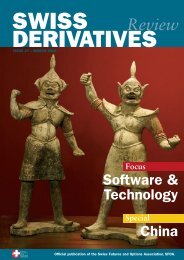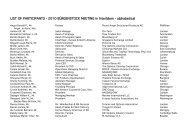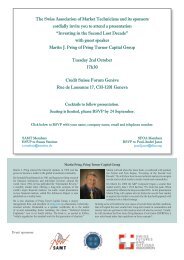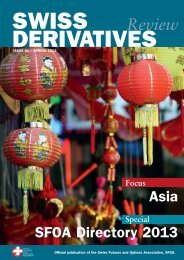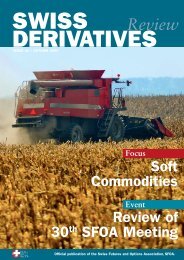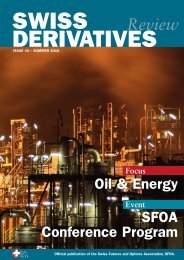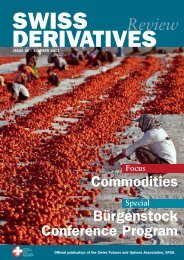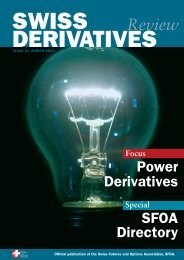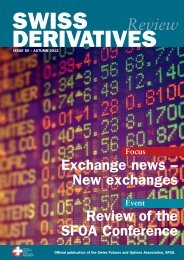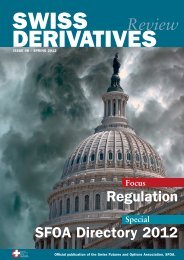Download PDF, Issue 26 - Swiss Futures and Options Association
Download PDF, Issue 26 - Swiss Futures and Options Association
Download PDF, Issue 26 - Swiss Futures and Options Association
You also want an ePaper? Increase the reach of your titles
YUMPU automatically turns print PDFs into web optimized ePapers that Google loves.
Emerging Markets<br />
A Perspective on Eastern<br />
European Exchanges<br />
The commodity exchanges in Central Eastern Europe (CEE) are relatively new <strong>and</strong> their range of products is still limited.<br />
Key challenges include the European integration <strong>and</strong> global competition. This article describes these developments, taking<br />
as an example the Romanian Commodities Exchange. It further comments on whether a regional commodity exchange<br />
could be a successful solution for the CEE countries as well as whether alliances between exchanges could reduce costs<br />
<strong>and</strong> increase revenues so that they be competitive in terms of EU st<strong>and</strong>ards.<br />
46<br />
Commodity Exchanges in Romania<br />
More than thirteen years after the start of transition to free<br />
market economy, the development of the financial <strong>and</strong> commodity<br />
markets in transition economies is still limited. As compared<br />
to developed economies, securities <strong>and</strong> commodities<br />
markets are still in the early stages of development <strong>and</strong> many<br />
further steps will have to be taken before drawing level with<br />
mature markets.<br />
The transition to free market economy, globalization <strong>and</strong><br />
the subsequent opening of commodity markets led to the<br />
dem<strong>and</strong> for risk management tools. As a result, many commodity<br />
<strong>and</strong> derivative exchanges were formed in Eastern<br />
Europe.<br />
In Romania, up to 15 exchanges were created between 1992<br />
<strong>and</strong> 2002. The application of the Law 512/2002 governing the<br />
commodity exchange field was the starting point of a rapid<br />
consolidation process taking place during 2003. The beginning<br />
of 2004 found a strong commodity exchange operating all over<br />
Romania: The Romanian Commodities Exchange (RCE).<br />
Overview of the RCE<br />
RCE is the leader in the national market <strong>and</strong> has as prime<br />
objective: to become a regional leader. Being aware that a<br />
national exchange has no real chance of survival without international<br />
connections, RCE is one of the founders of the<br />
<strong>Association</strong> of <strong>Futures</strong> Markets (AFM). RCE is also on excellent<br />
terms with the world’s major exchanges <strong>and</strong> participates in<br />
international events. Since 2001, RCE through the AFM,<br />
became an important participant in the annual gathering of the<br />
international exchanges on Bürgenstock.<br />
The RCE was officially established on November 20, 1992,<br />
while the first trading session took place on December 10,<br />
1992. The RCE is a joint stock company, organized in accordance<br />
with the rules <strong>and</strong> regulations of the traditional<br />
exchanges in the world. The RCE ownership structure encompasses<br />
120 shareholders: commercial banks, investment companies,<br />
brokerage companies, as well as foreign trade companies.<br />
RCE develops cash markets for grains, oil <strong>and</strong> oil products,<br />
metals, scraps, etc. Also, since 1998, RCE develops a<br />
derivatives market for currencies <strong>and</strong> interest rate products.<br />
In 2003, the trading volume increased to approximately USD<br />
1.3 bn, meaning a 600% increase year-on-year.<br />
The RCE has five years’ experience on the futures market,<br />
with its electronic trading system implemented three years ago.<br />
This electronic system allows the quotations display on the<br />
RCE web-site in real time. In figures, the futures <strong>and</strong> options<br />
market as at December 31, 2003 boasts 45,940 traded<br />
contracts, a total exchange capitalisation of ROL<br />
1,050,027,785,808 <strong>and</strong> a total number of 2,463 transactions<br />
made through the electronic trading system. The most important<br />
contract on this market is the <strong>Futures</strong> contract “Dollar<br />
RCE”.<br />
Although the futures market volume doubled year-on-year,<br />
this trend is not representative for the Romanian market in<br />
general, where the main operators, such as commercial banks,<br />
lack a legal framework to operate on this market. In 2004,<br />
despite constraints in relation with the general economic environment,<br />
the RCE futures market matured <strong>and</strong> further developed<br />
its specific instruments <strong>and</strong> trading process. Notwithst<strong>and</strong>ing<br />
the current legal premise, the launching of new<br />
underlying assets, such as indexes, T-Bills, <strong>and</strong> commodities,<br />
will bring a significant increase of the trading volume in 2004.<br />
As future projects, the RCE focuses its efforts on organising<br />
efficient regional cash markets for grains <strong>and</strong> petroleum products<br />
as a basis for a commodities futures market, exp<strong>and</strong>ing the<br />
terminals network throughout the country, trading commercial<br />
receivables, <strong>and</strong> consolidating the existing derivatives market.<br />
Future organization of CEE exchanges:<br />
how many options?<br />
What future is awaiting the commodity exchanges in the CEE<br />
countries given the fast EU integration process, which means<br />
that they will be part of a more developed European market?<br />
The global competition, the market internalization <strong>and</strong> the<br />
consolidation of trading systems in Europe could make it more<br />
difficult for the CEE exchanges to survive, especially for the<br />
small ones. Exchanges <strong>and</strong> policy makers are aware of these<br />
issues <strong>and</strong> are responding in a number of ways. The exchange<br />
of information <strong>and</strong> a closer cooperation in view of establishing<br />
different types of alliances are the main responses. <strong>Association</strong>s<br />
of emerging markets like the <strong>Association</strong> of <strong>Futures</strong> Markets<br />
(having the Secretariat in Budapest) are one example. Also, the<br />
alliances already in place among stock exchanges, such as the<br />
Warsaw Stock Exchange with Euronext, represent an alternative.<br />
We can see several options for the commodity exchanges:<br />
the integration in a regional commodity exchange, such as the<br />
RCE, individual alliances with a western exchanges, or a<br />
regional platform incorporated in a western exchange. Of<br />
course, each exchange should make a choice after assessing<br />
costs, benefits <strong>and</strong> risks associated with each of these options.<br />
Liliana Paraipan, Director Marketing & PR, Romanian<br />
Commodities Exchange, Bucharest. Tel: +40 21 2244742,<br />
Fax: +40 21 2242878, l.paraipan@brm.ro, www.brm.ro<br />
SWISS DERIVATIVES REVIEW <strong>26</strong> – NOVEMBER 2004




